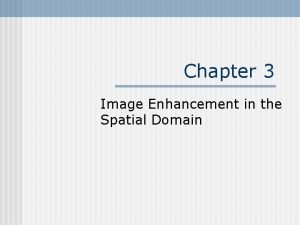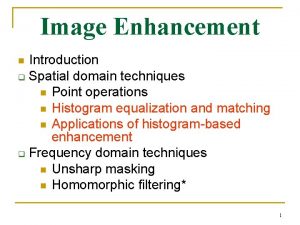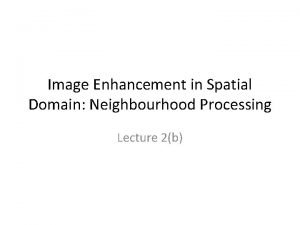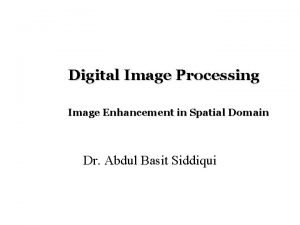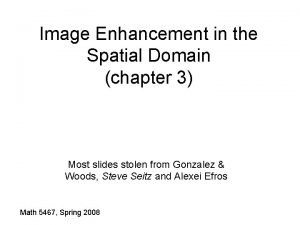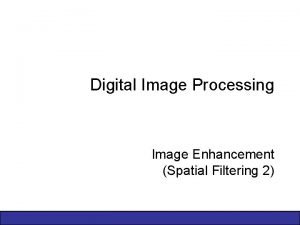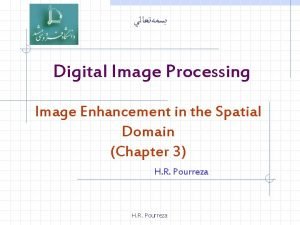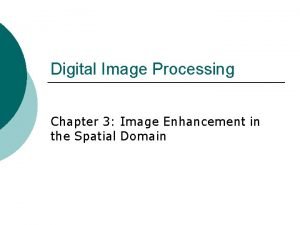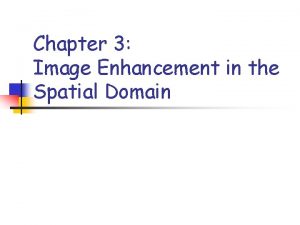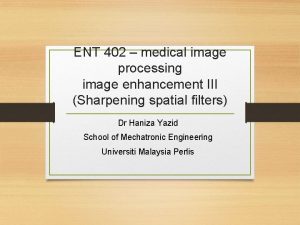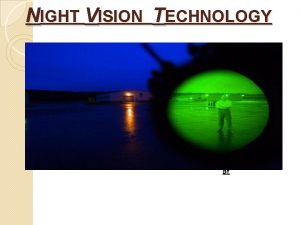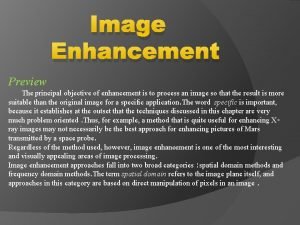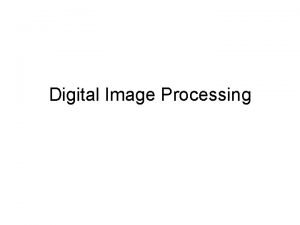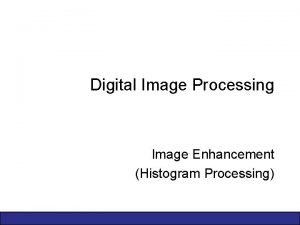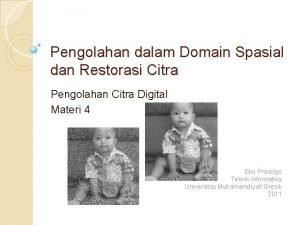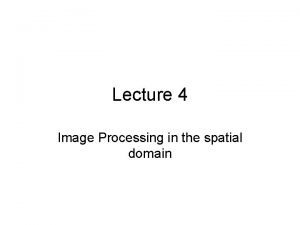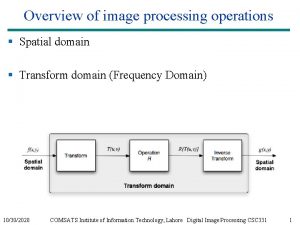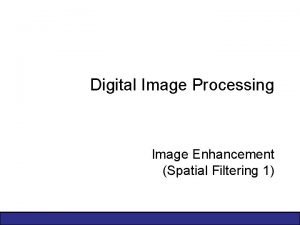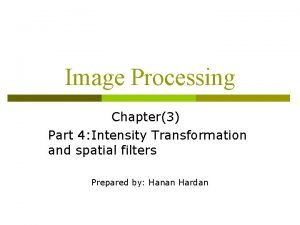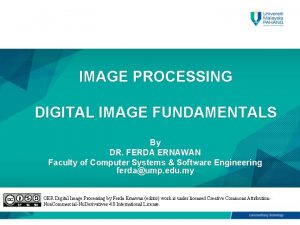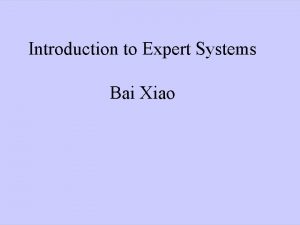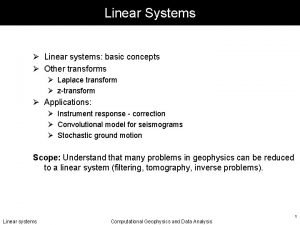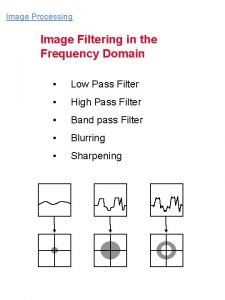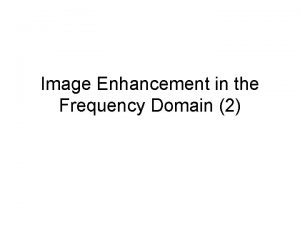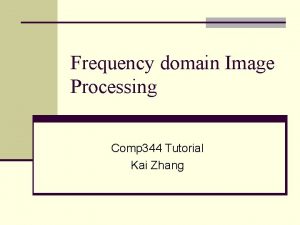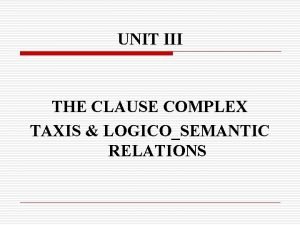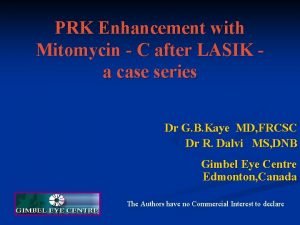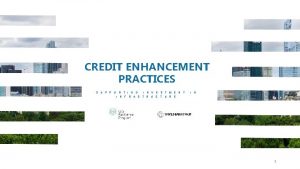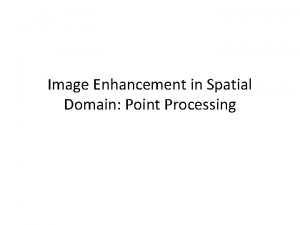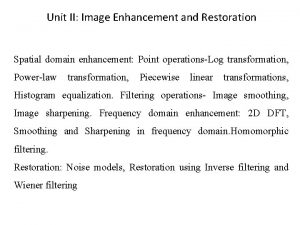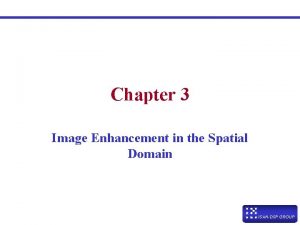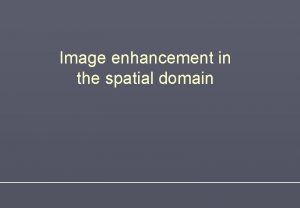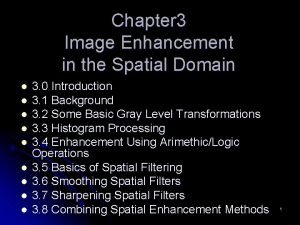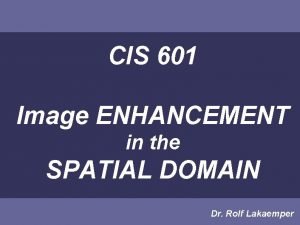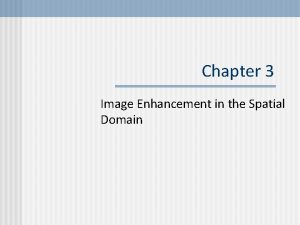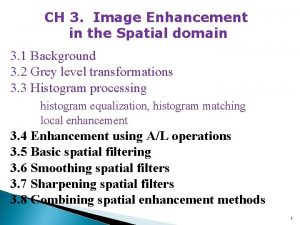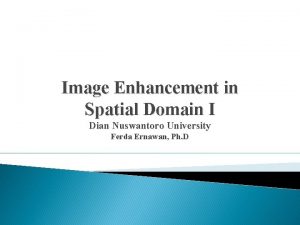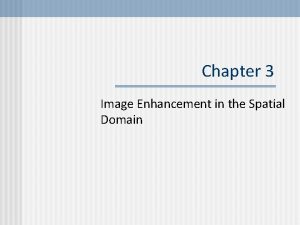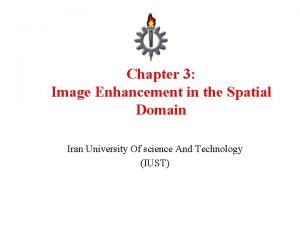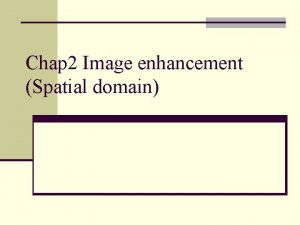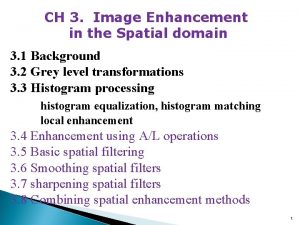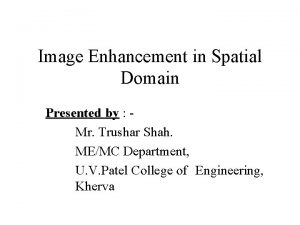CH 3 Image Enhancement in the Spatial domain












































- Slides: 44

CH 3. Image Enhancement in the Spatial domain 3. 1 Background 3. 2 Grey level transformations 3. 3 Histogram processing histogram equalization, histogram matching local enhancement 3. 4 Enhancement using A/L operations 3. 5 Basic spatial filtering 3. 6 Smoothing spatial filters 3. 7 sharpening spatial filters 3. 8 Combining spatial enhancement methods 1

3. 1 Background • Why image enhancement ? 1. processing an images so that the result is more suitable than the original image for a SPECIFIC application. 2. Providing `better' input for other automated image processing techniques. • Two approaches - Spatial domain methods: operate directly on pixels - Frequency domain methods: operate on the Fourier transform of an image 2

3. 1 Background • What is spatial domain? - it refers to the aggregated of pixels composing an image. • Spatial domain processes will be denoted by the expression g(x, y)=T[f(x, y)] where f(x, y) is the input image, g(x, y) is the processed image (output image), and T is an operator of f 3

Background 4

Background Gray-level transformation functions for contrast Enhancement. 5

3. 2 Gray-Level Transformations Some basic gray-level transformations: Three basic types of functions (Fig. 3. 3) used for image enhancement: • Image negative transformations • Log transformations • Power-law transformations 6

7

Gray-Level Transformations § Image negative transform: s = T(r) • obtained by using the negative transformation s = L-1 – r e. g. Input=10, output=255 -10 - produces the equivalent of a photographic negative - suited for enhancing white or gray detail embedded in dark regions of an image. 8

3. 2. 1 Image negative 9

3. 2. 2 Log transformations § Log transformations: s = c log(1+r) - Expand the values of dark pixels while compressing the high-level values - Compress the dynamic range of images with large variations 10

3. 2. 2 Log transformations INPUT IMAGE LOG TRANFORM IMAGE 11

3. 2. 2 Log transformations 12

3. 2. 3 Power-law transformations 13

3. 2. 3 Power-law transformations 14

3. 2. 3 Power-law transformations 15

3. 2. 3 Power-law transformations 16

3. 2. 3 Power-law transformations 17

3. 2. 4 Piecewise-linear transform functions • Advantage: its form can be arbitrary complex over the previous functions • Disadvantage: require considerably more user input § Contrast stretching - One of the simplest piecewise function - Increase the dynamic range of the gray levels in the image - A typical transformation: control the shape of the transformation e. g. if r 1 = r 2, s 1=0 and s 2=L-1 threshold function 18

3. 2. 4 Piecewise-linear transform functions 19

Contrast stretching 20

3. 2. 4 Piecewise-linear transform functions § Gray-level slicing - Highlight a specific range of gray levels - Display a high value for all gray levels in the range of interest and a low value for all other gray levels : produce a binary image (Fig. 3. 11(a)) - Preserving background (Fig. 3. 11(b)) 21

Gray-level slicing 22

Bit-plane slicing § Bit-plane slicing - Suppose that each pixel in an image is represented by 8 bits. - Imagine that the image is composed of eight 1 -bit planes, ranging from bit-plane 0 (the least significant bit) to bit-plane 7 (the most significant bit). 23

Bit-plane slicing Original Image Bit-plane 7 Bit-plane 6 Bit-plane 4 Bit-plane 1 24

25

3. 3 Histogram Processing Types of processing: • Histogram Equalization • Histogram Matching(Specification) • Local Enhancement 26

3. 3. 1 Histogram equalization Histogram Equalization: - produce a level s for every pixel value r in the input image. - the transformation function T(r) satisfies the following: (a) T(r) is single-valued and monotonically increasing in the interval 0 ≤ r ≤ 1; and (b) 0 ≤ T(r) ≤ 1 for 0 ≤ r ≤ 1 27

3. 3. 1 Histogram equalization 28

3. 3. 1 Histogram equalization - n = total # of pixel, nk = #of pixel having gray-level k - Probability of occurrence of gray-level rk Pr(rk) = nk/n - Cumulative Distribution Function(CDF) - Histogram equalization(HE) results are similar to contrast stretching - the advantage: HE automatically determines a transformation function to produce a new image with a uniform histogram. 29



3. 3. 1 Histogram equalization 32

3. 3. 2 Histogram matching/specification Enhancement based on a uniform histogram is not always the best approach It is useful sometimes to specify the shape of the histogram that we wish to have Suitable for interactive image enhancement Difficulty--building a meaningful histogram The procedure for histogram matching (Page 99)

3. 3. 2 Histogram matching/specification - Specify the desired density function and obtain the transformation function G(z): pz: specified desirable PDF for output -Find z by using s = v 34

Image Enhancement in the Spatial Domain

3. 3. 2 Histogram matching/specification 36

3. 3. 2 Histogram matching/specification 37

3. 3. 2 Histogram matching/specification 38

3. 3. 3 Histogram Local Enhancement § Normally, transformation function based on the content of an entire image. § Some cases it is necessary to enhance details over small areas in an image. § The histogram processing techniques are easily adaptable to local enhancement. 39

3. 3. 3 Histogram Local Enhancement 40

3. 3. 4 Histogram Statistics for Image Enhanc. Contrast manipulation using local statistics (the mean and variance) is useful for images where part of the image is acceptable, but other parts may contain hidden features of interest. 41

42

3. 3. 4 Histogram Statistics for Image Enhanced Image Original Image 43

Summary 3. 1 Background ◦ Why enhancement? Specific app. ◦ Spatial/freq. domain 3. 2 Grey level transformations ◦ ◦ Image negatives Log transformations Power-law transformations Piecewise-linear transformation function Contrast stretching, gray-level slicing, bit-plane-slicing 3. 3 Histogram processing ◦ histogram equalization, ◦ histogram matching ◦ local enhancement t
 Combining spatial enhancement methods
Combining spatial enhancement methods Image enhancement in spatial domain
Image enhancement in spatial domain Image enhancement in spatial domain
Image enhancement in spatial domain Image enhancement in spatial domain
Image enhancement in spatial domain What is enhancement in the spatial domain?
What is enhancement in the spatial domain? Combining spatial enhancement methods
Combining spatial enhancement methods Enhancement using arithmetic/logic operations
Enhancement using arithmetic/logic operations Combining spatial enhancement methods
Combining spatial enhancement methods Combining spatial enhancement methods
Combining spatial enhancement methods Idl medical ent
Idl medical ent Oflinemaps
Oflinemaps Image enhancement in night vision technology
Image enhancement in night vision technology Objective of image enhancement
Objective of image enhancement Gamma correction image processing
Gamma correction image processing Define point processing
Define point processing Contrast stretching
Contrast stretching Gonzalez
Gonzalez Arithmetic
Arithmetic Spatial domain
Spatial domain Spatial operations in image processing
Spatial operations in image processing In digital image processing
In digital image processing Types of spatial filtering in digital image processing
Types of spatial filtering in digital image processing Image compression in digital image processing
Image compression in digital image processing Oerdigital
Oerdigital Domain co domain and range of a relation
Domain co domain and range of a relation Z domain to frequency domain
Z domain to frequency domain What is time domain and frequency domain
What is time domain and frequency domain Ec2314 digital signal processing
Ec2314 digital signal processing Z transform derivative
Z transform derivative Domain specific vs domain general
Domain specific vs domain general Domain specific vs domain general
Domain specific vs domain general Problem domain vs knowledge domain
Problem domain vs knowledge domain S domain to z domain
S domain to z domain What are language processing activities
What are language processing activities Frequency domain image
Frequency domain image Frequency domain image
Frequency domain image Image processing frequency domain
Image processing frequency domain Paractactic
Paractactic Family enhancement center
Family enhancement center Digital print enhancement
Digital print enhancement Prk enhancement after lasik
Prk enhancement after lasik Inverter nmos
Inverter nmos Modular operational ration enhancement
Modular operational ration enhancement Credit enhancement example
Credit enhancement example Coalition for physician enhancement
Coalition for physician enhancement
